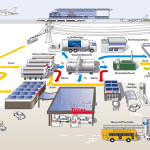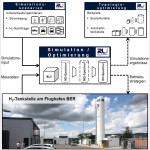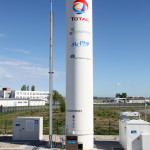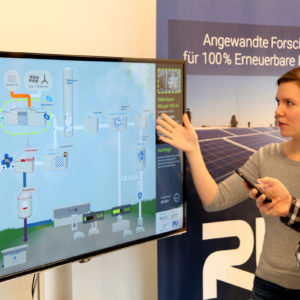
D3 – Micro Smart Grid EUREF (Twinlab)
1. September 2015Erster Status-Workshop “Smart Energy Ostdeutschland”
28. September 2015H2BER
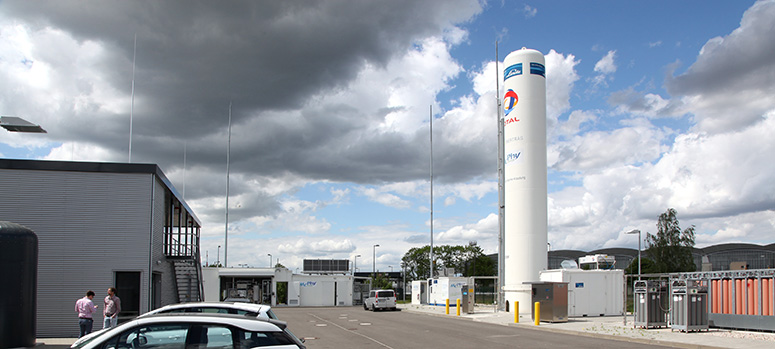
Development, testing and assessment of intelligent operating strategies for different components and the main controller of the hydrogen refueling station at BER airport
Project duration: 01.01.2015 - 31.12.2016
The objective of the H2BER project was to determine the optimized technical layout and mode of operation of a hydrogen refueling station. In order to achieve this, project partners Total, Linde, McPhy and 2G added hydrogen (H2) as a fuel to the existing refueling station at Berlin airport BER. Passenger cars with 700 bar hydrogen storage can be refueled as well as 350 bar vehicles (busses as well as passenger cars).
In these vehicles, hydrogen together with oxygen is transformed into water, electric energy, and heat. The produced electric energy is used by the car's electric motor in order to power the vehicle. Thus, harmful emissions can be avoided and noise pollution can be reduced considerably – an important step towards sustainable mobility.
In order to avoid emissions from occurring during the production of hydrogen instead, so called "green" hydrogen is used at the refueling station. This hydrogen is produced at the station through electrolysis using water and renewable energy. Before it can be refueled into the vehicle, hydrogen must be compressed to the required pressure in several steps. Furthermore, H2 buffer storage is necessary. In this project, different storage technologies were utilized. Besides gaseous low, medium and high pressure storages, a metal hydride storage system was tested for the first time in Germany. The produced H2 was not only used for refueling vehicles, but can also be used in a combined heat and power plant (CHP).
The aim of the project was to reduce the costs of hydrogen production by optimizing the technical layout of each component. With the aid of an intelligent mode of operation, the prime cost of hydrogen could be reduced in each scenario – especially when coupling the refueling station with a wind turbine, significant effects were observed.
The objective of the H2BER project was to determine the optimized technical layout and mode of operation of a hydrogen refueling station. In order to achieve this, project partners Total, Linde, McPhy and 2G added hydrogen (H2) as a fuel to the existing refueling station at Berlin airport BER. Passenger cars with 700 bar hydrogen storage can be refueled as well as 350 bar vehicles (busses as well as passenger cars).
In these vehicles, hydrogen together with oxygen is transformed into water, electric energy, and heat. The produced electric energy is used by the car's electric motor in order to power the vehicle. Thus, harmful emissions can be avoided and noise pollution can be reduced considerably – an important step towards sustainable mobility.
In order to avoid emissions from occurring during the production of hydrogen instead, so called "green" hydrogen is used at the refueling station. This hydrogen is produced at the station through electrolysis using water and renewable energy. Before it can be refueled into the vehicle, hydrogen must be compressed to the required pressure in several steps. Furthermore, H2 buffer storage is necessary. In this project, different storage technologies were utilized. Besides gaseous low, medium and high pressure storages, a metal hydride storage system was tested for the first time in Germany. The produced H2 was not only used for refueling vehicles, but can also be used in a combined heat and power plant (CHP).
The aim of the project was to reduce the costs of hydrogen production by optimizing the technical layout of each component. With the aid of an intelligent mode of operation, the prime cost of hydrogen could be reduced in each scenario – especially when coupling the refueling station with a wind turbine, significant effects were observed.
Pictures
- The refueling station at BER airport with all its components | © Image: Courtesy of TOTAL S.E.
- Diagram of optimized topology and operational strategy of the refueling station | © Image: RLI
- Hydrogen storage of the refueling station | © Image: RLI
- The demonstrator allows users to understand the functionality of the refueling station and to control it using a smartphone | © Image: RLI
Within the research project, the RLI focused on the following tasks:
- Scientific supervision
- Design and development of a simulation model of the entire plant
- Validation of each component of the refueling station using collected data
- Development of operational strategies based on the simulation model
- Assessment of operational strategy according to technical, economic, and ecological criteria
- Optimization of operations on the basis of the simulation model
- Scenario analysis with regard to alternative sources of electricity and alternative uses of hydrogen as well as optimized fuel station topologies
- Development of a demonstrator, which visualizes the concept of hydrogen mobility and the principle of H2 refueling stations at the BER and provides viewers with an interactive experience
After the research project has been completed, the RLI concludes the following results:
- The topology and operation of the hydrogen refueling station was optimized in different scenarios. In order to do so, simulation tools were developed on the basis of existing models and then validated with collected data.
- An intelligent operational strategy with forecasting was simulated. Prognoses with regard to demand, electricity costs, and the availability of wind energy were taken into account.
- The costs of hydrogen production were lowered by up to 18% by optimizing topology and coupling the station with a wind turbine.
- The intelligent operational strategy led to reduced costs in each scenario. Especially the connection to a wind farm and participation in the regular electricity market allowed the reduction of hydrogen production costs.
- On-site electrolysis was shown to be a suitable method for providing the refueling station with hydrogen. It was possible to react to signals regarding electricity pricing and wind prognoses very well, which allowed costs to be reduced.
- A significant portion of hydrogen production costs can be traced back to levies, taxes, and duties, which leads to generally high costs of hydrogen production of over 10 €/kg despite optimization.
- An interactive demonstrator was developed and set up on site for knowledge dissemination, which depicts the interaction of all components.
This project is funded within the NIP ("National Innovation Programme Hydrogen and Fuel Cell Technology") by the Federal Ministry of Transport and Digital Infrastructure (BMVI). It is coordinated by the National Organisation Hydrogen and Fuel Cell Technology (NOW).

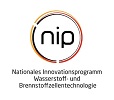


Fabian Grüger, Fabian Möhrke, “Reducing wind farm forecast errors and providing balancing energy with a fuel cell/electrolyzer system”, European Fuel Cell Conference & Exhibition 2015.
Fabian Grueger, Fabian Möhrke, Martin Robinius, Detlef Stolten, Early power to gas applications: Reducing wind farm forecast errors and providing secondary control reserve, Applied Energy, Available online 12 July 2016, ISSN 0306-2619
Fabian Grueger, Fabian Möhrke, Martin Robinius, Detlef Stolten, Early power to gas applications: Reducing wind farm forecast errors and providing secondary control reserve, Applied Energy, Available online 12 July 2016, ISSN 0306-2619





